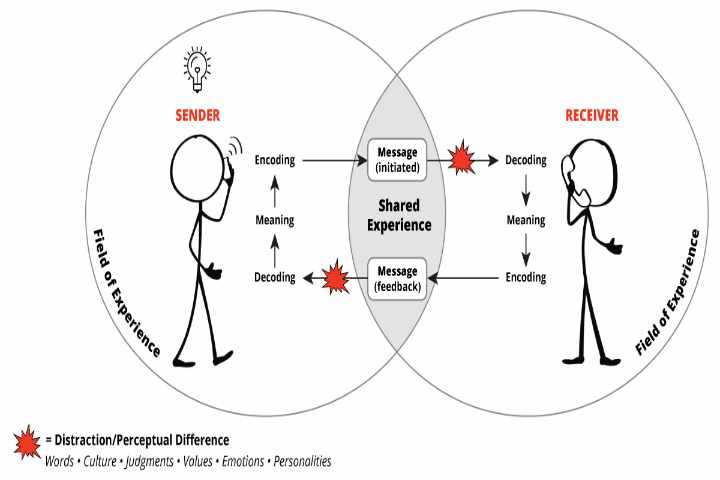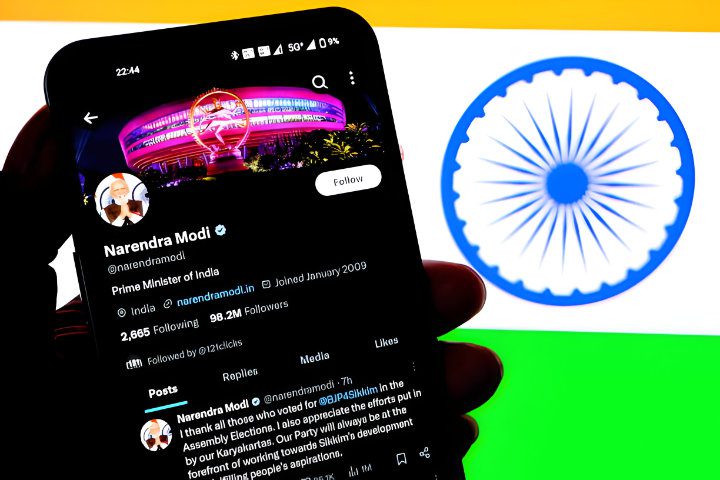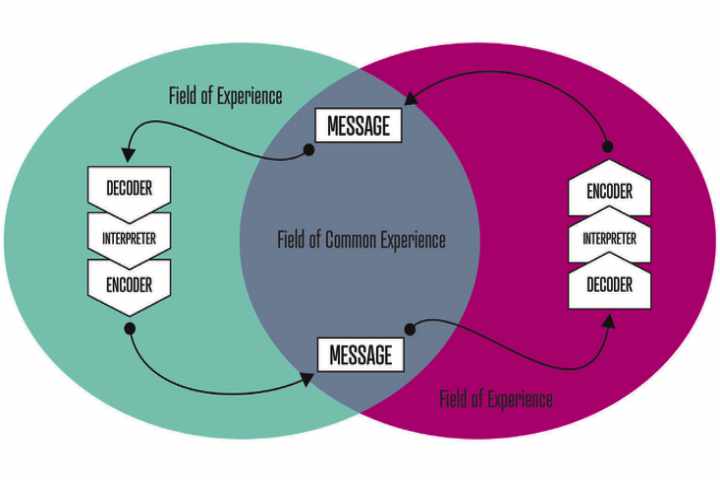Wilbur Schramm Model of Communication
Wilbur Schramm’s model in communication theory has evolved significantly from earlier linear models. The Schramm’s Model, developed in 1954, emphasizes the circular nature of communication and introduces the concept of feedback, making it a more dynamic and interactive representation of the communication process.
This model offers valuable insights into the intricacies of human communication and media effects.
The Wilbur Schramm Model of Communication is significant because it focuses on the encoder’s and decoder’s roles in communication and acknowledges the value of shared fields of experience among communicators.
We will explore Schramm’s model, looking at its components, applications, strengths, limitations, and relevance in today’s media landscape.
Components of Schramm’s Model

1. Source/Encoder
2. Message
3. Encoder
4. Channel
5. Decoder
6. Receiver
7. Feedback
8. Field of Experience
Let’s examine each of these components in detail:
Source/Encoder
The source is the originator of the message. In Schramm’s Model, the source serves as the encoder, transforming thoughts into messages that can be communicated.
For instance, a news anchor serves as the source and encoder while delivering news.
Message
The message is the information or idea being communicated.
Government announcements about new policies or initiatives are a message.
Encoder
The encoder translates the message into a form that can be transmitted through the chosen channel.
Example: A journalist writing an article for The Hindu converts information into written text.
Channel
The medium through which the message is transmitted.
Example: All India Radio (AIR) uses radio waves to broadcast programs.
Decoder
The process by which the receiver interprets and makes sense of the message.
Example: A viewer interpreting a Bollywood film’s storyline and themes.
Receiver
The person or group for whom the message is intended.
Example: The audience is watching a cricket match on Star Sports.
Feedback
The receiver’s response completes the circular nature of communication in Schramm’s model.
Example: Viewers calling in to express opinions during a live TV debate.
Field of Experience
The sender’s and receiver’s backgrounds, cultures, and experiences influence how messages are encoded and decoded.
Example: The shared cultural understanding that allows Indian audiences to appreciate nuances in Bollywood films.
Application of Wilbur Schramm Model of Communication
Television News Broadcast

Consider a prime-time news show on NDTV:
- Source/Encoder: News anchor and Production Team
- Message: Current events and analysis
- Channel: Television broadcast
- Decoder/Receiver: Viewers at home
- Feedback: Social media reactions, TRP ratings
- Field of Experience: Shared understanding of Indian politics and culture
Social Media Communication

Apply the model to a viral tweet during a cricket match:
- Source/Encoder: Cricket fan or sports journalist
- Message: Commentary on match events
- Channel: Twitter platform
- Decoder/Receiver: Other Twitter users
- Feedback: Retweets, likes, and replies
- Field of Experience: Knowledge of cricket and Indian sports, Culture
Advertising Campaign

Consider a pan-India advertising campaign for a new smartphone:
- Source/Encoder: Advertising agency
- Message: Features and benefits of the new phone
- Channel: Multiple (TV, print, digital)
- Decoder/Receiver: Potential consumers
- Feedback: Sales figures, social media engagement
- Field of Experience: Understanding of technology and consumer behavior in India
Strengths of Schramm’s Model
1. Circular Nature: Recognizes communication as an ongoing process rather than a linear event.
2. Emphasis on Feedback: Highlights the importance of audience response in shaping communication.
3. Field of Experience: Acknowledges the role of cultural and personal context in communication.
4. Versatility: Can be applied to various forms of communication, from interpersonal to mass media.
Limitations of Schramm’s Model
1. Simplification: May oversimplify complex communication processes.
2. Shared Experience Assumption: This assumption assumes that there is a certain level of commonality between the sender and receiver, which may not always be the case.
3. Limited Focus on Noise: This model doesn’t explicitly address external factors that might interfere with communication.
4. Lack of Specificity: It doesn’t provide detailed insights into how each component of the model functions.
Schramm’s Model in the Digital Age
Although the Wilbur Schramm Model of Communication was developed before the digital revolution, it continues to be significant in today’s media landscape.
1. Quick Feedback: Digital platforms allow for almost immediate feedback, highlighting the cyclical nature of communication.
2. Multiple Channels: The model applies to multi-channel communication strategies commonly used in digital marketing.
3. Expanded Fields of Experience: Global digital connectivity has broadened shared cultural experiences.
4. User-Generated Content: Social media blurs the lines between source and receiver, aligning with Schramm’s emphasis on the dual role of communicators.
Case Study: Schramm’s Model and Political Communication

Let’s apply the Wilbur Schramm Model of Communication to political communication on Twitter in India:
- Source/Encoder: Political leader (e.g., Prime Minister Narendra Modi)
- Message: Policy announcements or public statements
- Channel: Twitter platform
- Decoder/Receiver: Indian citizens and global audience
- Feedback: Retweets, comments, and media coverage
- Field of Experience: Understanding of Indian politics, culture, and current affairs
This case demonstrates how Schramm’s Model can be adapted to analyze modern digital communication processes in the Indian context.
Criticism and Evolution
Although the Wilbur Schramm Model of Communication has had a significant impact, it has been criticized for potentially oversimplifying the communication process. Some critics argue that it fails to consider the intricacies of mass communication or the influence of gatekeepers in the media.
Additional models have been created to address these criticisms, including the Westley and MacLean Model, which considers the role of gatekeepers, and the Convergence Model, which highlights communication as a process of mutual understanding.
Despite these criticisms, Schramm’s Model remains valuable for its emphasis on the circular nature of communication and the importance of shared experiences in effective communication.
Schramm’s Model and Media Literacy
Schramm’s Model offers important insights for media literacy:
1. Active Audience: It portrays audience members as active participants in the communication process.
2. Context Awareness: The model encourages consideration of how personal and cultural contexts influence message interpretation.
3. Feedback Importance: It highlights the role of audience feedback in shaping media content.
In India, where media literacy initiatives are gaining importance, understanding Schramm’s Model can enhance critical thinking about media messages and their effects.
Conclusion
The Wilbur Schramm Model of Communication, emphasizing the circular nature of communication and the importance of shared experiences, remains a relevant and insightful framework for understanding communication processes.
For UGC-NET aspirants, mastering this model is essential for exam success and developing a nuanced understanding of how media messages are created, transmitted, and interpreted in various social and cultural contexts.
The model can be applied to various scenarios in the Indian media landscape, including traditional broadcasting and digital social media communication. Although it has some limitations, it still offers a valuable foundation for analyzing the interactive nature of communication despite not fully capturing the complexities of modern mass communication.
Schramm’s insights into the circular nature of communication and the importance of shared fields of experience remain relevant in today’s digital age of global connectivity. The model highlights the importance of effective communication, which involves creating shared meaning through ongoing interaction and feedback.
UGC NET Preparation Tips
1. Understand the circular nature of communication, as Schramm’s model depicts.
2. Be able to explain the role of each component in the model, particularly the concepts of encoding and decoding.
3. Practice applying the model to various communication scenarios in the Indian context.
4. Understand both the strengths and limitations of the model.
5. Consider how modern digital communication might adapt or challenge the model.




